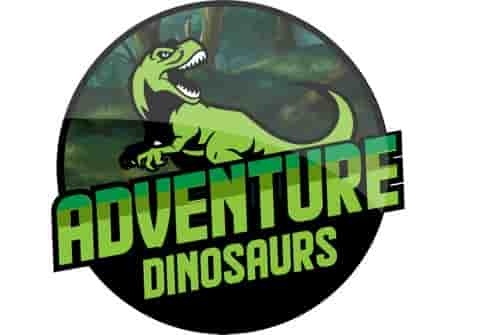“What Are Long Neck Dinosaurs?” conjures images of the majestic Sauropods, towering giants of the Mesozoic era. These prehistoric behemoths, like the iconic Brachiosaurus, evolved their elongated necks possibly to reach the lush canopies of ancient forests, giving them an edge in the survival game. Whenever I hear the phrase “animals with long necks,” my mind thinks instantly of giraffes. They are known that they have long necks for reaching out to the upper canopy of trees. From the colossal Argentinosaurus to the graceful Diplodocus, these creatures roamed the Earth for millions of years, their necks becoming symbols of prehistoric prowess. The question of why they evolved such extraordinary anatomical features is a banquet for the curious mind, offering a glimpse into the complex tapestry of natural selection and the diverse strategies life on Earth employs to thrive.
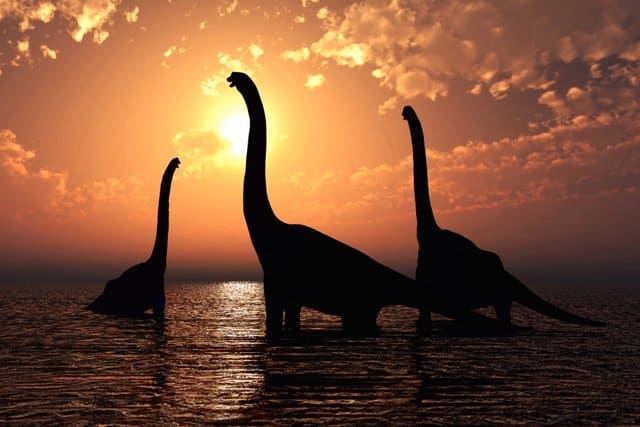
What Are Long Neck Dinosaurs?
Long neck dinosaurs are Sauropods, a species of dinosaur that lived in the Mesozoic Era. They are noted to have developed lengthy necks, up to 30 feet (9.1 meters), tree trunk legs, and relatively small heads.
Key Takeaways
- Sauropods, or long-neck dinosaurs, lived in the Mesozoic Era, reaching enormous sizes and living globally.
- Evidence suggests Sauropods like Brontosaurus, Apatosaurus, and Diplodocus could create supersonic cracks with their tails.
- Despite their size, Sauropods didn’t chew their food well; their digestion relied heavily on powerful stomach enzymes.
- Sauropods had an intriguing anatomy, their brain was 26 feet above their heart which weighed over 200 kg.
- Contrary to past beliefs, the Brontosaurus was found to be unique enough to be its own dinosaur classification.
- The Mamenchisaurus, Brachiosaurus, and Alamosaurus were among some of the largest Sauropods, reaching lengths over 30 meters.
Dominated by the towering figures of Sauropods, the Mesozoic era was a chapter in Earth’s history where long neck dinosaurs ruled. Their distinct anatomy, particularly their extended necks that consisted of a multitude of vertebrae, aided them in their herbivorous lifestyle, reaching high foliage that other species couldn’t.
Table of Contents
Among the myriad of species were the Brachiosaurus, the Diplodocus, the Apatosaurus, and the gargantuan Argentinosaurus, all featuring under Titanosaurs. Their impressive scales, coupled with their hardy bones, left an extensive trail of fossils that enrich our knowledge of natural history.
Before these regal beasts, there were the Prosauropods, whose evolution led to the spectacular size of their successors, the sauropods. But despite their imposing stature and dominance, they fell prey to extinction, marking their end at the close of the Cretaceous period.
Sauropods are a subgroup of dinosaurs. Dinosaurs within this subgroup have long necks. Long necks feature prominently in Brachiosaurus. Brachiosaurus is a genus of sauropod dinosaurs. Dinosaurs such as Diplodocus also belong to sauropods. Diplodocus possesses an extraordinarily lengthy neck.
Sauropods demonstrate herbivorous behavior. A herbivorous diet characterizes these long-necked creatures. The Mesozoic Era is the geological time frame when sauropods thrived. The end of the Cretaceous period marks the extinction of sauropods. The film Jurassic Park culturally popularized Brachiosaurus.
Argentinosaurus is considered among the largest sauropods. Fossil evidence indicates the massive size of Argentinosaurus. Paleontology is the field dedicated to studying these prehistoric creatures. Sauropods fall within the study of paleontology. Dinosauria is the clade encompassing all dinosaurs, including sauropods.
Camarasaurus adds to sauropod diversity. Vertebrate classification includes Camarasaurus due to its spinal anatomy. Plateosaurus displays evolutionary beginnings. The early sauropodomorph Plateosaurus shows the development of elongated necks. Cervical vertebrae provide support. These vertebrae form the long neck structure in sauropods.
The long neck Sauropods existed for approximately 140 million years that span across the Mesozoic Era, making them one of the most successful dinosaurs that lived in all three periods of the Mesozoic. Let’s take a deeper look at these Sauropods, understand better why they had developed long necks, and more about the characteristics and habitat of these dinosaurs. Read on to learn more!
What is a Dinosaur with a Long Neck Called? All About Sauropods
The long neck dinosaurs are called Sauropods. The word Sauropoda comes from the Greek word meaning “lizard-footed.” It was coined and used for the first time in 1878 by a paleontologist named O. C. Marsh.
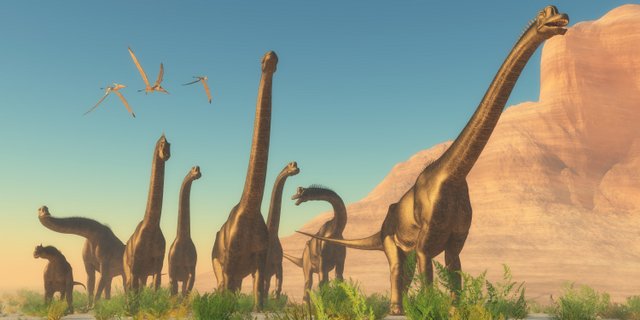
Dinosaurs with long necks lived from the Early Jurassic up to the Late Cretaceous period, spanning a range of approximately 201 to 66 million years ago. Furthermore, long-neck dinosaurs, specifically sauropods, were known to have lived all over the world. Fossil specimens have even been discovered in unexpected places like Antarctica and distributed across all current continents.
Wikipedia describes Sauropods as having “very long necks, long tails small heads (relative to the rest of their body), and four thick pillar-like legs. They are notable for the enormous sizes attained by some species, and the group includes the largest animals to have ever lived on land”.
The following table provides a comprehensive overview of the characteristics and unique features of the Sauropods, also known as long-necked dinosaurs or sauropodomorphs. This group of herbivorous dinosaurs lived during the late Jurassic period, around 150 million years ago, and are renowned for their gigantic size, making them some of the largest land animals to have ever existed.
| Characteristic | Description | Significance |
|---|---|---|
| Time Period | Late Jurassic period, approximately 150 million years ago. | It gives us an idea of when these magnificent creatures roamed the Earth. |
| Size | Among the largest land animals to ever tread the planet’s surface. | Highlights the immense scale of these creatures. |
| Physical Features | Exceptionally long necks and tails, small heads, large bodies and thick legs. | These features enabled the sauropods to reach high vegetation and support their massive bodies. |
| Species | Brachiosaurus, diplodocus, apatosaurus, camarasaurus, Argentinosaurus, and Mamenchisaurus. | Species of sauropods have been found on all continents of the world. |
| Diet | Herbivorous, feeding on plants and foliage high above the ground. | This specialized feeding behavior allowed them to thrive in environments abundant with tall trees and lush foliage. |
| Significance | A reminder of the incredible diversity and complexity of life that once existed on our planet. | Provides a perspective on the grandeur and complexity of ancient life forms. |
Long Neck Dinosaurs – Sauropod Anatomy Details
Sauropods were dinosaurs with great body mass. You can tell just by looking at the skeletons how massive these dinosaurs were. According to different theories, we can estimate that for the larger mature species, it may have reached a mass bodyweight of 80 metric tons (80,000 kg). The length of their body can reach more than 110 feet (33.5 meters). Even the smallest of these dinosaurs had a length of more than 20 feet (6.1 meters).
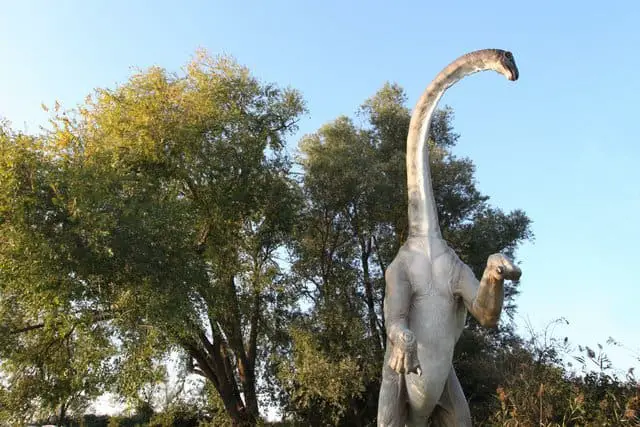
They had tree trunk sized tails, with the ability to bear such a heavyweight that it’s speculated that some of the dinosaurs could stand on its rear two legs, possibly for reaching more vegetation in trees, but also for fighting against predators. One interesting study about Sauropod tails (Source) suggests that dinosaurs like Brontosaurus, Apatosaurus and Diplodocus could whip their tail and make a loud, even supersonic, cracking sound. It could be used as a weapon against predators or to scare them away.
All of the Sauropods were plant-eaters, and recent studies on their jaws are show that they did not chew their food well. Instead, and they had powerful enzymes in the stomach to help digest their food and eating more than 100,000 calories a day.
Sauropods could replace their teeth quickly. It took approximately 14 days to 64 days to completely replace a tooth. As Sauropods were herbivores, the shape of their teeth was flatter or at least cone-shaped, used for grinding vegetation. If you are interested to know more about dinosaur teeth, both herbivore and carnivore, check out my article on this website, “What’s the Value of a Real Dinosaur Tooth (Single, On Jawbone)?”
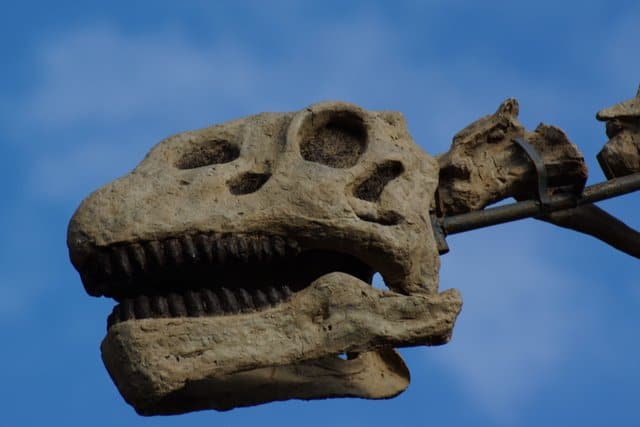
- How did long neck dinosaurs use their long necks?
Long neck dinosaurs used their long necks to reach vegetation that was high in the trees, allowing them to access food that other dinosaurs couldn’t reach. - What did long neck dinosaurs primarily eat?
Long neck dinosaurs were herbivorous, meaning they primarily ate plants. - What is the time period in which long neck dinosaurs lived?
Long neck dinosaurs lived during the late Jurassic period, which was around 150 million years ago. - What is the size range of long neck dinosaurs?
Long neck dinosaurs can vary in size, ranging from about 50 to 100 feet in length, with some species reaching even greater lengths. - What are the distinguishing characteristics of long neck dinosaurs?
Long neck dinosaurs, officially known as sauropods, have small heads, long tails, long necks, large bodies, and thick legs.
Which Dinosaur Has the Longest Neck According to The Guinness World Records?
According to the Guinness World Records, the dinosaur with the longest neck is believed to be the Sauroposeidon species. These incredible creatures possessed necks that measured over 55 feet in length, surpassing any other known dinosaur. The remarkable specimen was discovered in the Xinjiang Uygur Autonomous Region of China, within rocks that date back approximately 162 million years. To put this into perspective, the neck of this particular sauropod dinosaur was about six times longer than that of a giraffe. It is speculated that this remarkable dinosaur may have had the longest neck of any animal to have ever roamed the Earth, accompanied by an equally immense body.
The table below provides a detailed view of some fascinating facts about the anatomy of Sauropods, a group of dinosaurs known for their long necks and massive bodies. This includes information about their hearts, lungs, reproduction, and growth.
| Anatomy Part | Interesting Fact | Additional Information |
|---|---|---|
| Brain | Positioned more than 26 feet (7.9 meters) above their heart | They kept their necks low to facilitate the pumping of blood |
| Heart | Weighed more than 200 kg (441 pounds) | More than the weight of three normal human adult beings |
| Neck and Lungs | Had a long neck and windpipe with additional air sacs | This helped support their respiratory system |
| Reproduction | All sauropods were oviparous (egg-laying) | Sauropod nest discoveries have been recently made |
| Growth | Newly born Sauropods needed only 23 years or less to grow | They could reach the full size of an 80 metric ton sauropod |
Use this table as a reference to gain a deeper understanding of these majestic creatures and the physiological traits that enabled them to thrive in their environments.
Some of them had developed some protective advancements like armor and tails with spikes, similar to other herbivore dinosaurs like Stegosaurus. If you want to know more about how dinosaurs protected themselves with armor and weapons, see my article to learn more! How Did Dinosaurs Protect Themselves? (Armor, Weapons)
Brontosaurus – The Well-Known Sauropod That Lost Its Name, Then Reclaimed It
One of the most well-known Sauropod dinosaurs, the Brontosaurus (meaning “thunder-lizard”), has an interesting history that has just been resolved in recent years. Skeletons of these giant Brontosaurus dinosaurs were found in the 1800s, but there was some mixing of the skeletons of Brontosaurus and the Apatosaurus (meaning “deceptive-lizard”), a similar Sauropod species. Both dinosaurs belong to the Diplodocids in scientific classification (taxonomy).
Well, in the 1970s, scientists realized that the skeletons built earlier had mixed the head of the Brontosaurus with the Apatosaurus. Therefore, they declared that the Brontosaurus did not exist. It was an Apatosaurus.
Fast forward to 2015, and scientists determined that the Brontosaurs is actually unique and different enough to be its own classification of a dinosaur. (Source)
The Brontosaurus excelsus is different from the Apatosaurus by having a higher neck and one that is less wide.
Sauropoda and Theropoda – The Duality Of These Dinosaur Groups
Sauropoda and Theropoda epitomize evolutionary divergence within dinosaurs. Sauropods, like Brachiosaurus and Diplodocus, were enormous, long-necked herbivores, capable of accessing lofty vegetation. Their adaptation to a herbivorous diet was enabled by extensive cervical vertebrae, facilitating high browsing with minimal competition. These quadrupeds also possessed large bodies and lengthy tails that might have served both offensive and communicative roles.
On the flip side, Theropods, including the notorious Tyrannosaurus rex and Velociraptor, were predominantly bipedal carnivores with shorter, muscular necks. Adaptations such as powerful hind legs and strong jaws with sharp teeth allowed them to pursue and subdue prey efficiently. Theropods occupied various ecological niches, from massive predators to nimble scavengers, until their line, save for the avian descendants, faced extinction at the close of the Cretaceous.
Why Did Dinosaurs Have Long Necks, and What is the Biggest Long Neck Dinosaur?
With the advancement of technology and recent improvements in the field of bioinformatics, many areas of research expand and develop. That goes as well for the study of dinosaurs. The paleontologist and other fossils lovers nowadays not only look for skeletons of dinosaurs, but they are focusing on what features and habitats of the dinosaurs had for all categories of discovered dinosaurs.
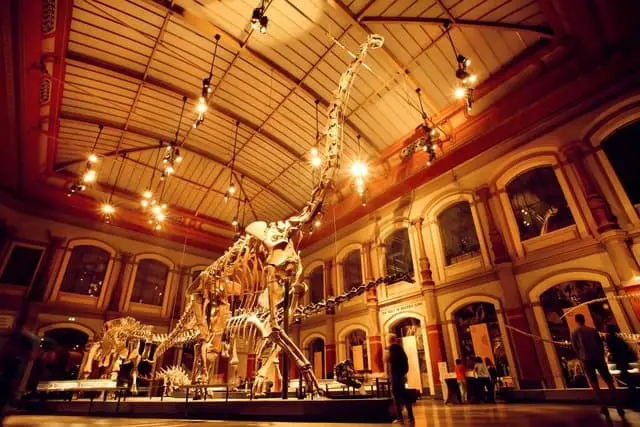
About That Long Neck
That brings us to the question of why did the Sauropods evolve such long necks? According to LiveScience (Source) https://www.livescience.com/27376-how-dinosaurs-grew-longest-necks.html, they have three possible theories. First, so that they could reach the high canopy tops of trees to eat, second, they could eat the vegetation from side to side like modern-day geese. And third, for fighting with other Sauropods during the mating process. It’s interesting that in present-day giraffes, we see these same characteristics and use of the long neck.
When it comes to answering which Sauropod had the longest neck, there is no definite conclusion. It is probably because the number or size of the neck vertebrae cannot always give the accurate size of the neck. So, here are the top three contenders for the longest neck dinosaur:
The Brachiosaurus
One of the dinosaurs that had one of the longest necks was the Brachiosaurus (meaning arm-lizard). The length of a Brachiosaurus neck could reach as much as 30 feet (xx meters), making the total length of the dinosaur (neck, body, and tail) up to 69 feet (21 meters). An interesting feature in the anatomy of the Brachiosaurus was that the two forelimbs were longer than the hindlimbs. The Brachiosaurus that was found in Colorado, USA, was specifically named Brachiosaurus altithorax (meaning deep chest) by its full name.
Other Brachiosaurus fossils have been found in the US states of Oklahoma, Utah, and Wyoming, although the fossils coming out of Colorado have been the most complete skeletons found.
The Diplodocus
Another contender for the longest neck was the Diplodocus (meaning double-beam). Many of the sources listed this dinosaur as having the longest neck.
Diplodocus was lived at the end of the Jurassic period. They were one of the dinosaurs who ate stones along with the vegetation to crush the food in their stomach during digestion. Most of the Diplodocus fossils are found in the Morrison Formation in Colorado, USA. The length of the Diplodocus neck in one of the most well-known fossils (Diplodocus carnegii found in Sheep Creek, Wyoming) had a neck that was at least 21 feet (6.5 meters) long.
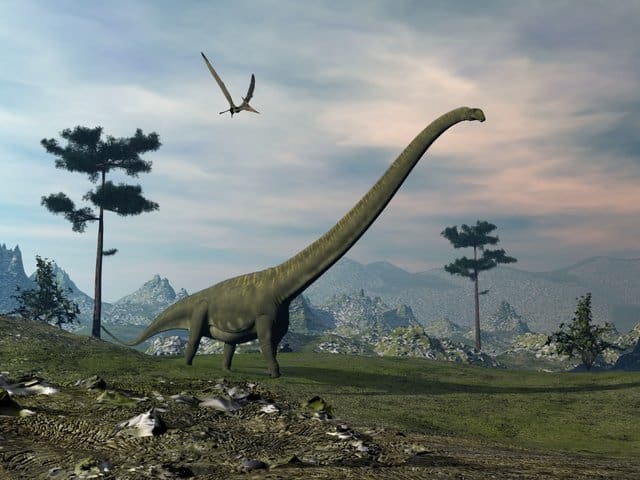
The Mamenchisaurus
The Mamenchisaurus was a Sauropod dinosaur that lived in China. The fossil skeleton found in Sichuan, China. The neck of the Mamenchisaurus was 32 feet long, and the total dinosaur measured an astonishing 90 feet (27.4 meters) from head to tail.
————————————————————————————————
Related Dinosaur Articles You Might Also Be Interested In:
Would A T-Rex Really Shake The Ground?
What’s the Difference Between Dinosaurs and Dragons?
How Would A T-Rex Get Up After Falling?
————————————————————————————————
List of Long Neck Dinosaurs
The lizard-foot Sauropod dinosaurs were the giants of the dinosaur family. It’s not a complete list by any means, but here are some of the better-known Sauropods:
- Argentinosaurus – was the known animal of all time they had their life in the late Cretaceous period. The main living area for them was today’s Argentina. They had more than 50 tons of weight, and they had their body length from 30 to 39 meters.
- Alamosaurus- was one of the largest dinosaurs of North America that lived in New Mexico. They weighed almost 30 tons and length more than 30 meters.
- Ultrasaurus- was known as great lizards. They lived 110 million years ago.
- Camarasaurus- was also known as chambered lizards. They lived between 145 to 155 million years ago. They were 23-meter-long, and the weight of them was 51 tons.
- Titanosaurids- were also known as “Titanic lizards.”
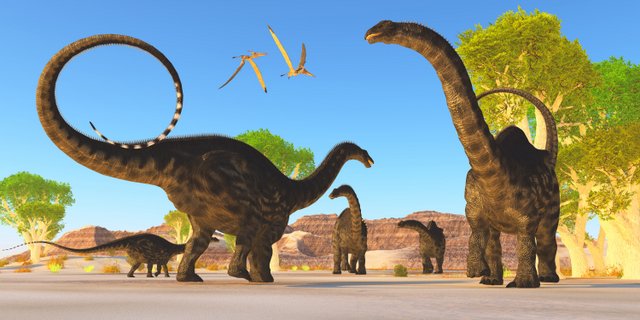
- Apatosaurus- was almost 22-meter-long and weighed between 16 to 13 tons.
- Opisthocoelicaudia- lived a late cretaceous period like 70 million years ago. They were one of the smallest of their kind having a length of just 11 meters.
- Haplocanthosaurus- lived 152 to 155 million years ago. They were quite small compared to their fellow species. The total length for them was 12 meters, and they got a total weight of about 14 tons.
Frequently Asked Questions
What Are Sauropods?
Sauropods, also described as long-necked dinosaurs, are a group of herbivorous dinosaurs that have extremely long necks and tails. They are considered to be one of the largest land animals to ever walk the earth.
Where Did Long Neck Dinosaurs Live?
Sauropods, the long neck dinosaurs, are known to have lived all over the world. Fossil specimens have even been found in Antarctica.
When Did Long Neck Dinosaurs Live?
Long neck dinosaurs lived from the Early Jurassic up to the Late Cretaceous period, around 201 to 66 million years ago.
Which Dinosaurs Are Considered Long Neck Dinosaurs?
Some of the well-known long neck dinosaurs include brachiosaurus, diplodocus, apatosaurus, camarasaurus, argentinosaurus, and mamenchisaurus.
What Is the Size of Long Neck Dinosaurs?
Long neck dinosaurs can be quite large. They range in size from about 50 to 100 feet in length, with some species reaching even greater lengths.
What Did Long Neck Dinosaurs Eat?
Long neck dinosaurs were herbivorous dinosaurs, meaning they primarily ate plants. They used their long necks to reach vegetation high in the trees.
How Did Long Neck Dinosaurs Use Their Long Necks?
Long neck dinosaurs used their long necks to reach vegetation that was high in the trees. This allowed them to access food that other dinosaurs couldn’t reach.
What Were the Neighbors of Apatosaurus in The Morrison Formation?
In the Morrison Formation, a geological formation from the Late Jurassic period around 155 million years ago, the Apatosaurus had neighboring dinosaur species such as the Camarasaurus. The Camarasaurus, known as the “chambered lizard,” earned its name due to the presence of hollow chambers within its cervical vertebrae. These chambers, discovered by scientists, served as air sacs that assisted in reducing the weight of the dinosaur’s body.
Did All Dinosaurs Have Long Necks and Tails?
No, not all dinosaurs had long necks and tails. While some dinosaurs, like the long neck dinosaurs, had extremely long necks and tails, others had shorter necks and tails.
Where Have Long Neck Dinosaur Fossils Been Discovered?
Long neck dinosaur fossils have been discovered in various regions around the world. Some notable locations include North America, where many famous long neck dinosaurs have been found.
Are There Any Long Neck Dinosaurs in Popular Culture?
Yes, long neck dinosaurs have appeared in popular culture, including books, movies, and television shows. They continue to captivate people’s imaginations with their incredible size and unique features.
What Is the Largest Long Neck Dinosaur Ever Discovered?
The brachiosaurus is considered to be one of the largest long neck dinosaurs ever discovered. It could reach lengths of up to 75 feet long and was one of the largest animals to ever walk the earth.
